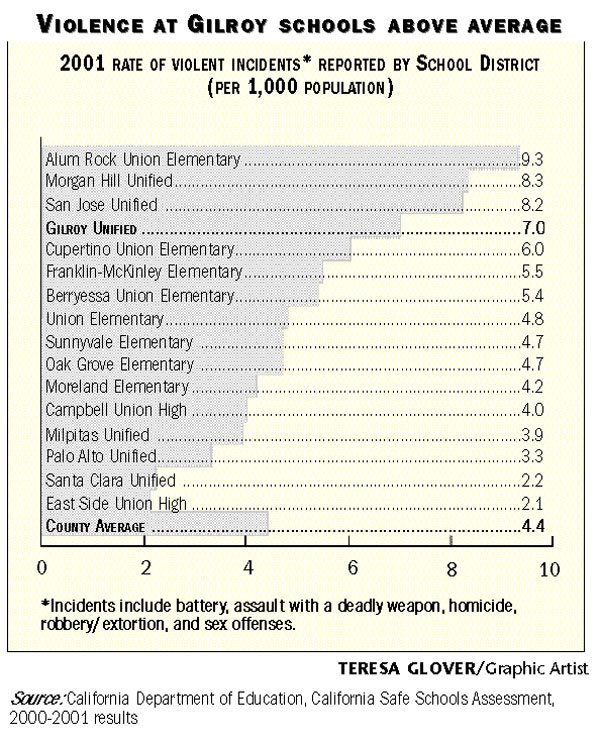GILROY
– The good news is you’re less likely to be murdered here than
in most places in the state or nation.
The bad news is you’re more likely to be beaten up.
There were only 38 homicides among Santa Clara County’s
1,795,132 residents in 2001, according to a new report called the
Community Profile on Violence, just published by the county
Department of Public Health using data from two years ago.
GILROY – The good news is you’re less likely to be murdered here than in most places in the state or nation.
The bad news is you’re more likely to be beaten up.
There were only 38 homicides among Santa Clara County’s 1,795,132 residents in 2001, according to a new report called the Community Profile on Violence, just published by the county Department of Public Health using data from two years ago. The county’s rate of 1.9 homicides per 100,000 people – down from 1999 – was less than a third of the national and state averages, and it easily met the target rate of 3.2 posed by the national Healthy People 2010 initiative. San Francisco County had more than four times as many homicides per capita in 2001 as Santa Clara, and Alameda County came close to that.
A lack of killings, however, doesn’t necessarily mean a lack of violence. Gilroy’s rate of 544 aggravated assaults reported per 100,000 residents in 2001 was well above state and national averages, and it led the county in this category. To be “aggravated,” an assault must be intended to inflict severe bodily harm or death and is often done with a weapon.
Gilroy also led the county in robberies, but there are still fewer robberies here per capita than in the state or nation as a whole.
In the domestic violence category, Gilroy ranked second in the county, behind Campbell. Its rate of domestic violence-related calls to police (512 per 100,000 residents) was above the national average but below that of the state. Countywide, the number of domestic violence-related calls has declined since the 1990s, and deaths attributed to domestic violence – 17 in 2001 – have dropped from a peak of 21 in 1997 (although mid-’90s numbers were lower).
For child abuse, the Gilroy and San Martin Zip Code areas led the county, along with central San Jose. These places had between 1,600 and 2,400 substantiated cases of child abuse per 100,000 residents – roughly 100 times more prevalent than in Los Altos, Palo Alto and Sunnyvale, where the rate was less than 20 cases.
The Gilroy Unified School District’s rate of violent incidents on school property was above the county average in 2001 but below those at schools in Alum Rock, Morgan Hill and San Jose.
Gilroy also had a high rating for rape: 16 forcible rapes in 2001, or 36 per 100,000 residents.
The police chief’s view
Gilroy Police Chief Gregg Giusiana said Gilroy has historically had problems with gang violence and domestic violence, but its rates of these – and violent crime in general – have been declining continuously for the last decade.
Gang activity in particular has dwindled to a shadow of its former presence, he said. There are so few gang-related crimes now in Gilroy that the police Anti-Crime Team – specially dedicated to monitoring gangs – spends more time doing proactive work to prevent gang activity than it does investigating incidents. When the ACT was formed a decade or so ago, Giusiana said, its officers had no time for gang prevention – just investigations and arrests.
Domestic violence is harder to deal with, Giusiana said. Basically, police want to increase awareness and reporting of this type of crime.
“That’s counterproductive in terms of numbers,” Giusiana said, “but in the long run it’s a good thing.”
Gilroy police have made great inroads into schools, with two police officers and a community service officer dedicated to them.
“This district takes a very tough stance on violence,” Giusiana said. “They report all violent incidents that happen on campus.”
Today, Giusiana said, Gilroy is “fairly safe.”
“We’re not having a lot of random stuff,” Giusiana said. “A lot of those assaults are people who get into a beef with each other, not people who are lurking in bushes.”
Giusiana said he had read the Profile on Violence but noted that, crime-wise, Gilroy is probably more comparable to Salinas, Watsonville and Hollister than to the rest of Santa Clara County. On Friday, police will present a Five-City Crime Rate Comparison (Salinas, Watsonville, Hollister, Morgan Hill and Gilroy), including 2002 data, to the City Council.
City council views
Gilroy City Councilman Roland Velasco emphasized that, in general, “Gilroy is a safe community” with a police department that “aggressively fights crime.”
Although Velasco had not read the Profile on Violence, he noted that Gilroy has a high youth population compared to other cities. Assaults and robberies are traditionally committed more often by young people than old, he said, so in that light, Gilroy’s high rates in these crime categories make sense.
Velasco added that seasonal agricultural workers – of which Gilroy has many – also cause violent crime numbers to rise.
The city’s biggest crime challenge, Velasco said, is “to ensure that we continue to give the police officers the tools and the training that they need to be effective out in the community. … To me, that’s a challenge because of the fiscal realities.”
City Councilman Craig Gartman said he was “a little surprised” and “saddened” to hear that that Gilroy’s crime numbers were so high.
The key, Gartman said, is to keep making city law-enforcement more visible – especially programs like the community service officers and the Gang Task Force. A stronger police presence makes people feel more secure, he said.
The city could also do a better job of publicizing and supporting the violence-intervention work of private, non-profit groups like Community Solutions, Gartman said.
In general, however, “I feel extremely safe in Gilroy,” Gartman said. “Our police department is very visible.”
Other violent crime statistics: Santa Clara County, 2001
• The homicide rate declined from 1999 to 2001.
• Males accounted for 90 percent of homicide convictions and 68 percent of homicide victims.
• County courts have joined in preventing domestic violence by issuing 12 times more protective restraining orders than they did a decade ago – 1,895 in 2001, compared to 159 in 1993.
• Eighty-seven percent of these restraining orders were against men.
• In 44 percent of domestic violence-related deaths, the couple was separated or divorced. In 27 percent, they were dating or formerly dating. In 17 percent, they were married.
• Nearly 26 percent of ninth- through 12-graders had engaged in a physical fight in the previous 12 months, below the national average of 33 percent.
• About seven percent of high-schoolers had carried a weapon on school property in the previous 30 days, compared to more than 17 percent nationwide.
• Three percent of high-schoolers had carried a gun to school in the past 12 months.
• The GUSD had the second-highest rate of property crimes among county schools; the leader, as for violent incidents, went to Alum Rock Union Elementary.














